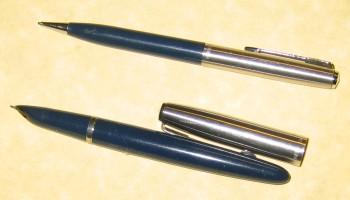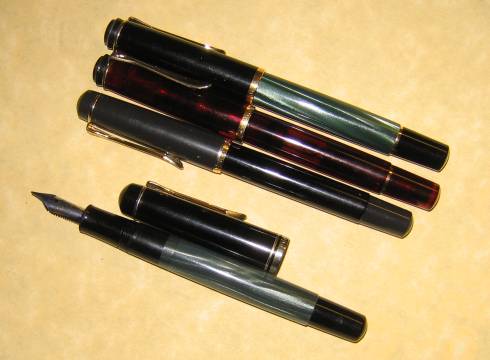
Why do orchestras still use real fiddles, when you can play a simulation of an entire string section from a keyboard? Why has there been a resurgence in organs with purely mechanical key actions, over the course of the last 60-70 years, after electric and electropneumatic actions are so more convenient, and a complete electronic simulacrum of an organ takes up a fraction of the space?
The crudest, cheapest, mass-produced fountain pens -- like the $2 Sheaffer cartridge-only models of the 1950s, 1960s, and 1970s, or the Pilot disposable models of today -- are elegant precision instruments, in ways that even the most expensive ballpoints are not. And even the stiffest fountain pen nibs are more responsive than any ballpoint can ever be.
The science teacher who got me seriously into fountain pens swore up and down that his writing was more legible with a fountain pen than with a ballpoint, and based on my own experiences, I'm inclined to think he wasn't imagining it. And since the only time you ever need pressure is when you're making carbon or carbonless copies, they're also much less fatiguing to write with.
My writing instrument of first choice has been a fountain pen since sometime in high school (now about two thirds of my life). I carry five fountain pens in my breast pocket, and I write in five colors (blue, black, red, green, and brown).

I've had a fascination with fountain pens since early childhood, one that, alas, is not shared by my parents, who were very quick to abandon them in favor of ballpoints. I still have my father's last one, a Parker 21, part of a pen-and-pencil set.
There are a number of misconceptions about fountain pens. Many people assume that they're too delicate (or too messy) for everyday use. If that were the case, then why are they still so popular in Europe and the Far East (especially since most cheap ballpoints are made in the Far East)? Likewise, many people look at a fountain pen with a traditional nib, and automatically assume that it's for calligraphy. While many fountain pen manufacturers market primarily to calligraphers (both professional and hobbyist), and calligraphy nibs are available for many fountain pen systems that use interchangeable nibs, so are ordinary writing nibs. Likewise, many people automatically assume that a fountain pen is ridiculously expensive. While many of the fountain pen manufacturers that are still in business today only sell very expensive pens, there are also many pens out there in the under-$100 price range, and quite a few in the under-$20 range, and even a very few still in the under-$10 range (including the disposable Pilot "Varsity" model. None of six fountain pens in my pocket cost me more than (maybe, at most) $120, and one of them (one that I extensively re-engineered) cost me under $20, and years ago, my old Sheaffer cartridge-only pen sold for under $2.
My first fountain pen was a 1960s-vintage Sheaffer cartridge-only model, blue with a metal cap, similar to this one. . .


Then, in the fall of 1976, I began high school, and my very first high school teacher, Bob Rolle (pronounced like "Raleigh"), who taught freshman physical science, turned out to be a fountain pen user (and also a semiprofessional beekeeper!), and he always carried two Sheaffer cartridge pens in his pocket, one filled with brown ink, the other with purple: he kept an open grade book, and used those colors to discourage students from acts of forgery in it.
This awakened my enthusiasm for fountain pens, and it wasn't all that long before I began carrying my Sheaffer. But soon, I wanted a "real" fountain pen: one designed to be filled from bottled ink, without having to disassemble the pen in order to fill it.
An upscale stationer at South Coast Plaza happened to carry fountain pens: in the "fine writing" section up front, they carried Parker pens, and back in the art supply section, they carried Osmiroid, an English brand that used the interchangeable nib system that Esterbrook had developed, years earlier. They offered a lever-fill (the only one on the market, at the time), the "65," and a piston-fill, the "75." And while they weren't the $1.50-$2.00 that Sheaffers were going for at the time, they were still only about $7-8. And while most of their nibs were intended for calligraphy (their primary market at the time), they did offer plain writing nibs as well.

I don't remember whether it was Christmas or my birthday, but I wanted an Osmiroid 75. My mother, however, insisted on getting me a Parker 25 instead, a pen that was everything I didn't want in a fountain pen: where I wanted a traditionally-shaped nib, on a traditionally-shaped barrel, the Parker 25 looked like a piece of bad modern art that happened to write. And where I wanted a pen designed to use bottled ink and only bottled ink, and to be filled without disassembly, this was a "cartridge/converter" model that came with a squeeze-fill converter. If I found the "hooded" nib of my father's Parker 51 to be less than appealing, I found the nib on my new Parker 25 to be downright offensive. And both of them had to be disassembled for filling.

I saw the Osmiroid 75 as the epitome of what I wanted (and a very affordable epitome, too, at about $3-4 cheaper than the Parker), but my mom saw it as cheap junk. (As it turned out, we were both right, but I wouldn't know that for a few years). At any rate, I convinced her to get the Osmiroid "in addition to" the Parker; the Parker never became anything more than an emergency back-up pen for me.
All through high school, I maintained my friendship with Mr. Rolle. When I wanted help with an 8mm movie about chemistry, he helped me with a number of demonstrations, including an ammonium dichromate volcano. And when I could no longer use a book locker (because somebody would find a way to kick it in, even if it was on the top row, where I could barely reach it), Mr. Rolle made space for me near his desk in the Science Department office.
In the Spring of 1980, when I graduated from high school, I bought appreciation gifts for a number of my teachers. In Mr. Rolle's case, the choice was obvious: refilling cartridges with a syringe is cumbersome and messy at best; I got him an Osmiroid 65.

Going on to CSU Long Beach, I gave up the Sheaffer,and switched to the Osmiroid 75 full-time, eventually also picking up a 65 (I kept blue ink in the 75, and black in the 65). I soon found that the osmiroid 65 had a fatal design flaw: the ink window was very fragile around the edges, and would eventually develop a hairline crack at the seam, just from the stress of everyday use. The crack would be just enough to slowly leak ink, right onto my fingers. After my second 75 cracked, I gave up on the model, and decided I needed something better. (The 65 also had a tendency to get ink on my fingers, from less-than-perfect threads in the nib socket, but at least that could be taken care of with a tiny bit of teflon tape on the threads.)
By then, the stationer where I'd bought my Osmiroids had closed for good, but I heard about another stationer near the Huntington Beach main post office, that carried fountain pens. The fountain pen expert eventually convinced me that not all piston-fill pens had the same fatal flaw as the Osmiroid 75, and I was all set to buy a bottom-of-the-line Omas. Then he got in a stock of something that was just starting to become available in the U.S.: Pelikan fountain pens.
Pelikan had been the original developer of the modern piston fill system, and I was already very familiar with their India ink. And their M200 model was only $45 at the time.

This time, my mother didn't argue with my traditional taste (and this time, she wasn't being asked to pass over a more expensive pen for a cheaper one), and so that M200 became either a Christmas present or a birthday present.
Around 1989, my first "real" boss took a trip to Germany, to represent our company at CeBIT. And he brought back gifts for everybody, including slim Elysse cartridge pens for several employees. I carried and used that Elysse until I started to wear the lacquer off.


Over the next 30 years, I would lose that first blue M200 (the only pen I've ever lost, that cost over $2) and eventually break the one that replaced it (not easy; M200s are built like tanks); I'm still carrying my third blue M200, along with a black-and-charcoal M150 (slightly smaller), a "red demonstrator" M200, and a green M200. All filled with ink of a roughly matching color.
But that was not enough. As a programmer, I find it useful to be able to write in different colors, the more, the better. I wanted brown next. And I wanted a brown pen for the brown ink. Unfortunately, low-end Pelikans don't come in anything even close to brown, and the high-end ones are too expensive to justify for an ink color I use no more than every other week. And brown pens in general are not common, particularly inexpensive lever- or piston-fills. So I decided to re-engineer a cheap cartridge/converter model. My first attempt was with Pelikan's cheapest cartridge/converter model, the Pelikano.
(Click on the image for how I did it.)
Unfortunately, the brown paint didn't like the plastic that Pelikan used for the Pelikano. It took forever to dry, and it didn't stick well. I eventually gave up on it, and started looking for a pen that was already brown, and cheap enough to re-engineer. I found one: one of my fellow Fountain Pen Network members is a dealer and importer, carrying a number of relatively obscure pens from the Far East. Including the Pirre Paul "Wood." At under $20, it was cheap enough to re-engineer, and that I did. And unlike the Pelikano, with the converter shaft extension simply sticking out the butt of the pen, for this one, I sliced the end off of the barrel, and made it the fill-knob.

![]() Fountain Pen Network is an online forum of fountain pen enthusiasts.
Fountain Pen Network is an online forum of fountain pen enthusiasts.
Richard Binder is an online pen merchant, custom nib grinder, and general fountain pen guru.
Norman Haase is another online pen merchant, the one who turned me on to Pirre Paul's pens.
![]()
Back Home
James H. H. Lampert
Copyright © James H. H. Lampert, 2011
Revised Tuesday, November 3rd, 2015
This Page URL: http://members.toast.net/JHHL/FountainPens/FountainPens.html
Home Page URL: http://members/toast.net/JHHL/index.html